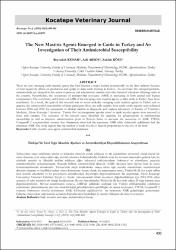| dc.contributor.author | Kenar, Beytullah | |
| dc.contributor.author | Aksoy, Adil | |
| dc.contributor.author | Köse, Zahide | |
| dc.date.accessioned | 2021-09-22T11:12:55Z | |
| dc.date.available | 2021-09-22T11:12:55Z | |
| dc.date.issued | 31.12.2019 | en_US |
| dc.identifier.citation | Kenar, B. , Aksoy, A. & Köse, Z. (2019). The New Mastitis Agents Emerged in Cattle in Turkey and An Investigation of Their Antimicrobial Susceptibility . Kocatepe Veterinary Journal , 12 (4) , 400-406 . DOI: | en_US |
| dc.identifier.uri | https://dergipark.org.tr/tr/pub/kvj/issue/48417/615875 | |
| dc.identifier.uri | https://doi.org/10.30607/kvj.615875 | |
| dc.identifier.uri | https://hdl.handle.net/11630/9217 | |
| dc.description.abstract | There are new emerging cattle mastitis agents that have become a major burden economically on the dairy industry because
of their negatively affects on production and quality in dairy cattle farming in Turkey,. To overcome this emerged problem,
antimicrobials are adopted in this sector to prevent and administrate mastitis and other bacterial infections affecting cattle in
the country. Nevertheless, the occurrence of antimicrobial resistance (AMR) is increasing in both animal and human
contaminants. The occurrence and features of AMR of the emerging cattle mastitis agents in dairy cattle in Turkey, have been
manifested. As a result, the goal of this research was to assess secluded emerging cattle mastitis agents in Turkey and to
appraise the antimicrobial susceptibility of these pathogens. Sixty one milk samples from cattle wwith mastitis were collected
between 2014 and 2018 for assessment of clinical mastitis in diagnostic and analysis laboratory of Faculty of Veterinary
Medicine, Afyon Kocatepe University. Twenty five microorganism species arised as cattle mastitis agents were assessed in
these milk samples. The outcomes of the present study identified the necessity for advancements in antimicrobial
stewardship as well as infection administration plans in Turkish farms to decrease the occurence of AMR. VITEK
Compact® 2 systemmethod showed that Streptococcus uberis had the maximum AMR while Globicatella sulfidifaciens had the
minimum AMR. The study depicts that the number of cattle mastitis is directly proportional to the size of the herd.
Keywords: Cattle, mastitis, new agent, antimicrobial resistance. | en_US |
| dc.description.abstract | Türkiye‟deki sütçü ineklerinin üretim ve kalitesine olumsuz yönde etkileyen ve süt endüstrisine ekonomik olarak büyük bir
zarar oluşturan yeni ortaya çıkan sığır mastitis etkenleri bulunmaktadır. Giderek artan bu sorunun üstesinden gelmek için, bu
sektörde mastitis ve ülkedeki inekleri etkileyen diğer bakteriyel enfeksiyonların önlenmesi ve yönetilmesi amacıyla
antimikrobiyaller kullanılmaktadır. Bununla birlikte, antimikrobiyal direncin (AMR) oluşumu hem hayvan hem de insan
kontaminantlarında artmaktadır. Türkiye‟deki sütçü ineklerinden ortaya çıkan sığır mastitis etkenlerinde antimikrobiyal
direncin oluşumu ve özellikleri açıkça ortaya konmuştur. Sonuç olarak, bu araştırmanın amacı, Türkiye'de ilk kez tespit edilen
inek mastitis etkenlerini ve bu patojenlerin antimikrobiyal duyarlılığını değerlendirmektir. Bu araştırmada Afyon Kocatepe
Üniversitesi Veteriner Fakültesi Teşhis ve Analiz Laboratuarında klinik mastitisin değerlendirilmesi için 2014-2018 yılları
arasında 61 adet mastitisli süt örneği incelenmiştir. Bu süt örneklerinden Türkiye‟de ilk kez izole edilen 25 sığır mastitis ajanı
değerlendirilmiştir.. Mevcut araştırmanın sonucu, AMR'nin gelişimini azaltmak için Türkiye çiftliklerindeki enfeksiyon
yönetiminin planlanmasının yanı sıra antimikrobiyal geliştirilmesinin gerekliliğini de ortaya koymuştur. VITEK Compact® 2
yöntemi Streptococcus uberis'in maksimum AMR, Globicatella sulfidifaciens‟in ise minimum AMR geliştirdiğini göstermiştir.
Çalışma, ortaya çıkan sığır mastitis sayısının doğrudan sürü büyüklüğü ile orantılı olduğunu da ortaya koymuştur. | en_US |
| dc.language.iso | eng | en_US |
| dc.publisher | Afyon Kocatepe Üniversitesi | en_US |
| dc.identifier.doi | 10.30607/kvj.615875 | en_US |
| dc.rights | info:eu-repo/semantics/openAccess | en_US |
| dc.subject | Cattle | en_US |
| dc.subject | Mastitis | en_US |
| dc.subject | New Agent | en_US |
| dc.subject | Antimicrobial Resistance | en_US |
| dc.title | The new mastitis agents emerged in cattle in Turkey and an investigation of their antimicrobial susceptibility | en_US |
| dc.title.alternative | Türkiye'de yeni sığır mastitis ajanları ve antimikrobiyal duyarlılıklarının araştırılması | en_US |
| dc.type | article | en_US |
| dc.relation.journal | Kocatepe Veteriner Dergisi | en_US |
| dc.department | Fakülteler, Veteriner Fakültesi, Klinik Öncesi Bilimler Bölümü | en_US |
| dc.authorid | 0000-0001-6573-680X | en_US |
| dc.authorid | 0000-0002-1521-3100 | en_US |
| dc.authorid | 0000-0002-2914-1582 | en_US |
| dc.identifier.volume | 12 | en_US |
| dc.identifier.startpage | 400 | en_US |
| dc.identifier.endpage | 406 | en_US |
| dc.identifier.issue | 4 | en_US |
| dc.relation.publicationcategory | Makale - Uluslararası Hakemli Dergi - Kurum Öğretim Elemanı | en_US |
| dc.contributor.institutionauthor | Kenar, Beytullah | |
| dc.contributor.institutionauthor | Köse, Zahide | |



















